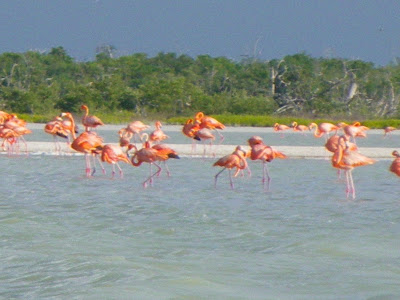Jumping a little tarpon along the mangrove edge
give the video a minute to load
give the video a minute to load
It has been almost two years since I picked up a fly rod - or any kind of fishing gear.
I have missed fishing and today, Tuesday May 25th, I'm still sore from this past Sunday's experience. I'll remember fishing in Rio Largatos for a good while. It turned out to be sort of like fishing for largemouth bass on steroids.
Diego Nunez, my guide, offered a choice of fishing in the Gulf of Mexico proper for big, 100-200lb, tarpon (sabalo) or fishing inside of the barrier island chain for "baby" tarpon and snook (robalo). There was a pretty stiff wind coming in from the Gulf and the open water was going to be pretty choppy so I picked the inside fishing. It was a good choice.
A long shallow bay runs east/west in front of the village of Rio Lagartos. It is called Estero Rio Lagartos. Most of the estero to the east is in the Reserva de la Biospera Ria Lagartos where Alice and I had gone the previous day to see the huge flocks of flamingos and other birds. Diego took me in his panga to the west end of the estero. We started fishing right out in the middle of this bay. It did not look like a good spot to me. The water there was only about a foot and a half deep. The bottom was covered with grass with occasional sand spots slightly deeper. I couldn't see anything that looked particularly fishy. There appeared to be no real structure. Diego told me that the tidal variation there was about one meter - not accounting for wind. And, when we started fishing the tide was about half and going down.
Diego stopped the panga and we began to drift with the wind and everything quieted down. I started to see baitfish everywhere, and then tarpon everywhere. Line management was a bear as the flyline did not want to stay on the deck due to the wind . Almost immediately I hooked up a nice fish for a couple of jumps and then off. Same thing again. When I slowed down the streamer I snagged the grass on the bottom. After four or five false starts I landed a nice 10 pounder. It was a beautiful fish that jumped a dozen times and ran the 9 weight deep into the backing several times.

Diego then suggested that I switch to a popper and then it really began to feel like bass fishing. The fish were very aggressive with the popper. And surprisingly, my solid hookup ratio improved.
There were so many fish to cast to that it was like dove hunting when a lot of birds are flying. I really had to concentrate on individual fish. - Lots of hookups, lots of jumps and I brought a half a dozen to the boat in the first hour.
Then we moved. It is always hard for me to leave fish when they are really being cooperative. But, Diego told me that we might find snook in another area to our south. There were numerous creeks and open spots emptying from a dense mangrove complex. We staked out near the mouth of a creek where a pretty deep hole was in shaded by large red mangroves mixed with the taller black mangroves.
First cast - bam a really big snook. He showed his wide back on the strike and gave me one jump, a nice look and sent my popper flying back at me.
We poled back into a couple of small openings in the mangrove where I caught a couple of smaller tarpon in very close quarters. Tough casting! And, I caught a lot of mangrove leaves.

We saw lots of smaller snook but they just weren't interested.
At around ten o'clock the heat began to set in and I was worn out. Solid casting, hook-ups and hook-offs, and releases since daybreak and it was time for me to quit.
My wrist is sore, my right arm is sore, my right side is sore. I've had a load of ibuprophen and I'm happy.
An interesting note:
The village is called Rio Lagartos
The reserve is called Ria Lagartos
It was explained to me by our birding guide, Roman Fernandez, that Ria is used to describe places where salt and fresh water meet.













